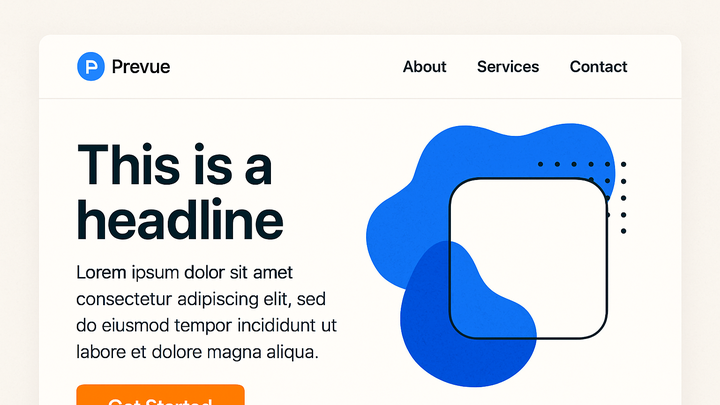Published on 2025-06-29T19:08:36Z
What is a Call to Action (CTA)? Examples and Best Practices
A Call to Action (CTA) is a prompt that encourages website visitors to take a specific action, such as signing up for a newsletter, downloading a resource, or making a purchase. In CRO, UX, and SEO, a well-crafted CTA is crucial for guiding users through the conversion funnel and improving engagement metrics. CTAs can take many forms—buttons, links, banners, or even pop-ups—but they all share the goal of driving a measurable result. Effective CTAs balance clear messaging, persuasive language, and accessible design to reduce friction and boost click-through rates. Tools like Prevue.me can provide actionable critiques on your CTA’s copy, design, and placement to maximize lead generation, SEO performance, UX quality, and accessibility compliance.
Call to action (cta)
A CTA is a strategic prompt guiding users to take a desired action on a website, boosting conversions and engagement.
Why CTAs Matter in CRO, UX, and SEO
CTAs are the linchpin of websites aiming to convert visitors into leads or customers. They serve as guideposts that nudge users toward the next step, whether that’s subscribing, downloading, or purchasing. Without clear CTAs, visitors can become confused or disengaged, leading to higher bounce rates and lost opportunities.
-
Driving user conversions
CTAs channel your audience toward conversion points, helping to reduce drop-offs and improve ROI.
-
Enhancing user experience
Well-placed CTAs reduce cognitive load by offering a clear next step, making the journey intuitive.
- Clarity:
Explicit language lets users know exactly what will happen when they click.
- Visual hierarchy:
Design cues like color, size, and positioning draw the eye toward CTAs.
- Clarity:
-
Boosting seo and engagement
Encouraging deeper interactions through CTAs lowers bounce rates and signals relevance to search engines.
Key Elements of an Effective CTA
An impactful CTA combines persuasive copy, standout design, and strategic placement. Each element works together to lower friction and motivate action.
-
Compelling copy
Use concise, action-oriented language that clearly states the benefit of clicking.
- Action verbs:
Start with verbs like ‘Download’, ‘Get’, or ‘Join’ to spark momentum.
- Value proposition:
Highlight what the user gains: e.g., ‘Get your free eBook’.
- Action verbs:
-
Visual design
Design CTAs that stand out while fitting seamlessly into your page aesthetic.
- Color contrast:
Choose contrasting hues to make the button pop against the background.
- Size and shape:
Ensure buttons are large enough for easy tapping on mobile devices.
- Whitespace:
Surround CTAs with ample space to avoid clutter and draw focus.
- Color contrast:
-
Strategic placement
Position CTAs near relevant content or at decision points to meet users where they are.
Examples and Best Practices
Real-world examples illustrate how to balance design, copy, and placement for maximum impact. Follow these patterns and adapt them to your brand voice.
-
Primary vs secondary ctas
Differentiate your main conversion goal from supportive actions using style and hierarchy.
- Primary cta:
Use for your most desired action, like ‘Sign Up’.
- Secondary cta:
Offer less critical options, like ‘Learn More’, in a more subdued style.
- Primary cta:
-
Html example
<a href='/signup' class='cta-button'>Get Started Free</a> -
Leveraging prevue.me
prevue.me analyzes your CTA’s copy, design, placement, and accessibility. It delivers prioritized, actionable critiques to maximize lead generation and UX performance across CRO, SEO, and accessibility.
Measuring and Optimizing CTAs
Continuous measurement and iteration ensure your CTAs stay effective. Track the right metrics and refine based on data-driven insights.
-
Key metrics
Monitor performance indicators to understand CTA effectiveness.
- Click-through rate (ctr):
Percentage of visitors who click the CTA.
- Conversion rate:
Percentage of CTA clicks that complete the desired action.
- Bounce rate:
High bounce rates may signal ineffective CTAs.
- Click-through rate (ctr):
-
A/b testing strategies
Run controlled experiments to discover which CTA variant performs best.
- Hypothesis-driven tests:
Formulate clear hypotheses about copy or design changes.
- Statistical significance:
Ensure sufficient traffic and duration for reliable conclusions.
- Hypothesis-driven tests:
-
Common pitfalls
Beware mistakes that undermine CTA performance.
- Too many ctas:
Avoid overwhelming users with competing actions.
- Vague language:
Steer clear of generic phrases like ‘Click Here’ without context.
- Poor contrast:
Low-contrast buttons can be overlooked or fail accessibility checks.
- Too many ctas:
